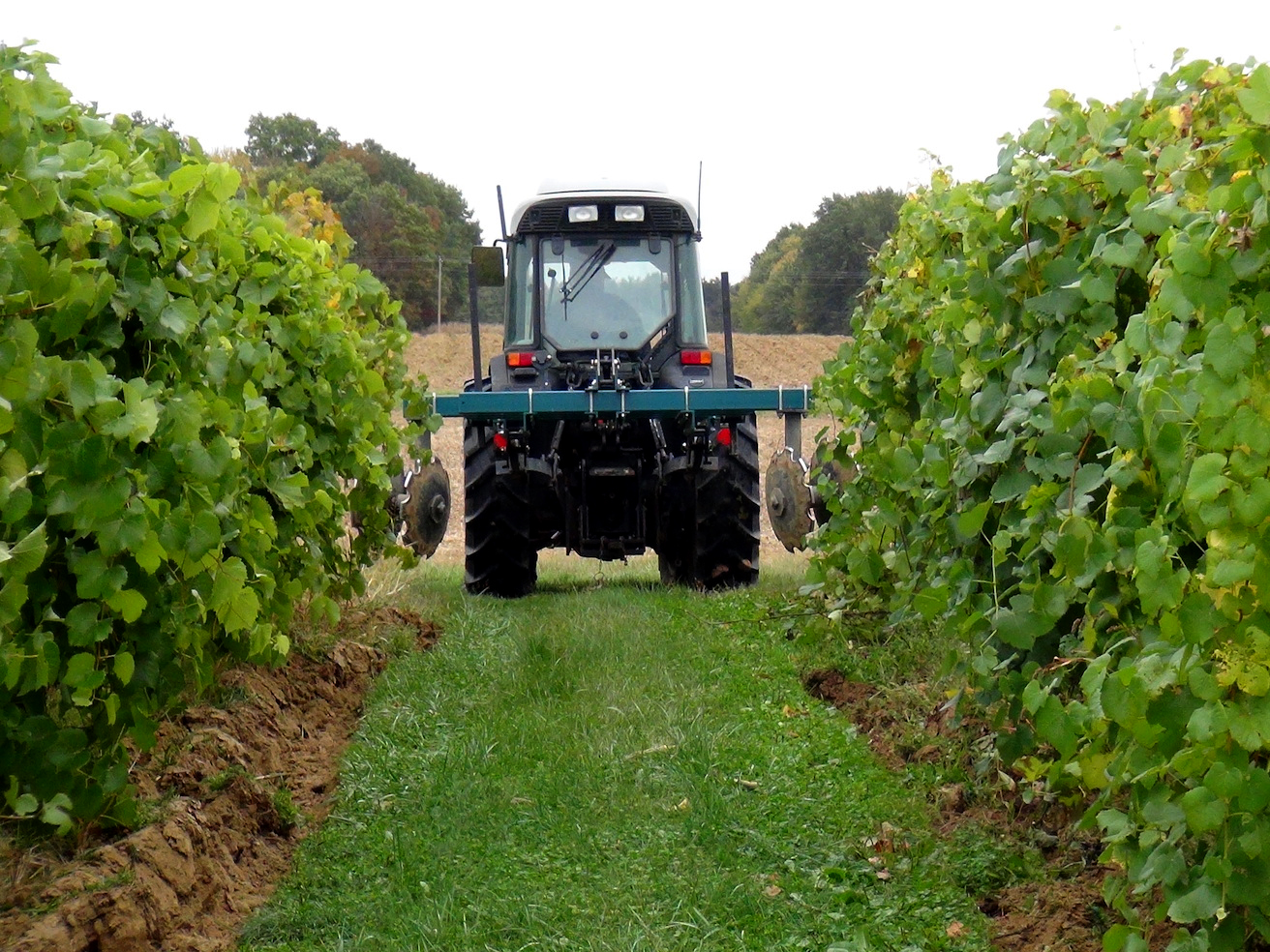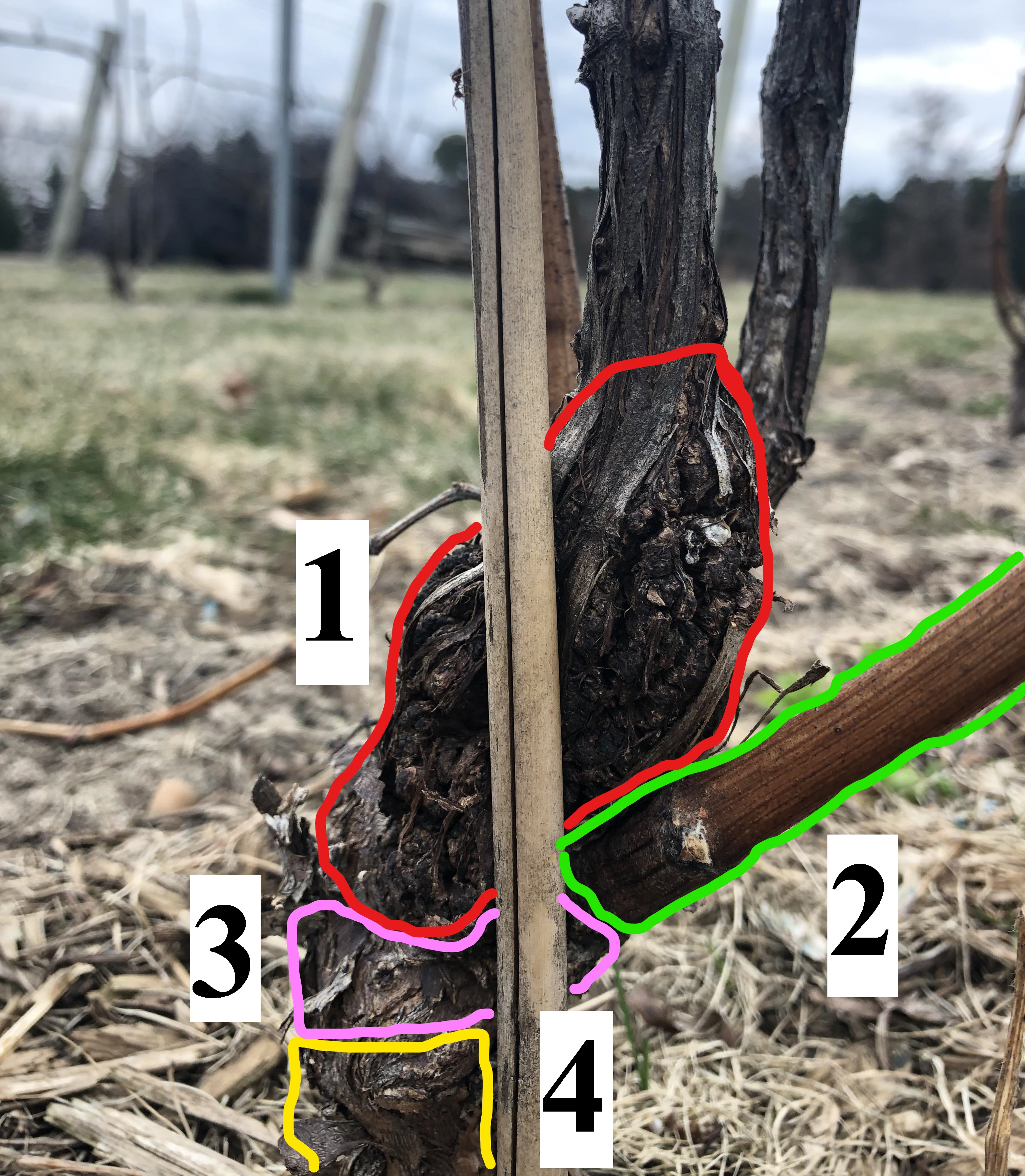Managing grapevine crown gall
There are several factors to consider when managing bacterial induced crown gall in grapes.

Introduction
Crown gall is a widespread and devastating disease, particularly in cool-climate regions in the world. Agrobacterium vitis is the bacterial pathogen that causes this disease in grapevines. The species A. tumefaciens, which is responsible for crown gall in several other crops, has been less commonly isolated from galls. In grapes, there are gall-forming and non-gall-forming types (strains) of A. vitis. Up until recently, it was thought that gall-forming strains were limited to commercial vineyards; however, the development of highly sensitive laboratory methods allowed the molecular detection of pathogenic strains in the wild grapevine relative Vitis riparia. For managing this disease, it is critical to understand the bacterium’s biology and make proper use of the available control strategies.
Disease symptoms
European grapevines, V. vinifera are particularly susceptible to crown gall. The most obvious symptom is the formation of disorganized, tumor-like masses that can grow several inches in size. These masses (galls) are typically located on graft unions or lower trunk wound sites close to the soil surface, but they can also be observed on cordons and canes of the grapevine (Fig. 1).
Actively-growing galls are soft and inside tissue is light in color. Old galls appear dry and may crumble. The formation of galls strangles the vine of nutrients and water, which leads to reduced vine vigor and yield. Young, infected vines are often rapidly killed. Infection of the root system results in necrotic (dead) tissue.
Disease cycle
The infection of a healthy vine usually begins at wounded sites caused by grafting, mechanical injury or freezing. Cold-climate viticulture regions are at higher risk of crown gall incidence due to repeated exposure to low temperatures. The grapevine cells in the injured tissue release chemical compounds (sugars and phenolics) that promote cell growth to repair the wound. These chemicals also attract A. vitis to the injury site, where the pathogen finds the plant cells that are susceptible to infection. Once the bacterium is in close contact with a susceptible plant cell, it delivers a piece of its genetic material (known as transfer-DNA) to the grapevine. This new information alters normal cell functions, directing the overproduction of plant hormones (auxin and cytokinin), which ultimately leads to uncontrolled plant cell division, growth and gall development.
The key aspect of the A. vitis disease cycle is that the bacterium causes systemic infections and can survive in infected grapevines without causing evident disease symptoms (asymptomatic infection). When conditions are conducive for disease development, this specific ability allows the bacterium to produce galls at injury sites occurring in aerial parts of the vine. It also plays a critical role in the bacterium’s dissemination through healthy-looking infected propagation material.
The bacterium can survive and maintain viability for several years in soil on dead or alive grape tissue. It is suggested that A. vitis mainly overwinters in the root system and is “swept” upwards in the xylem due to root pressure in early spring. Additional evidence suggests the bacterium distributes unevenly both within and between vines and can survive epiphytically (meaning on the surface) on any kind of vine tissue, including leaves and shoot tips.
Cultural control methods

Currently, there are no synthetic chemical treatments for controlling crown gall of grape. However, the following pest management practices recommended by Michigan State University Extension can be used to modify the cropping environment and make it less suitable for disease development.
Before establishing a new vineyard, select a site where freeze damage is less likely or A. vitis has not been introduced. Allow a minimum of two years after complete vine removal when replanting an old vineyard block with crown gall history. Agrobacterium species are common soil inhabitants; however, gall-forming strains are moved into new areas with infected plant material. Therefore, the next important consideration is to obtain “clean” plants whenever possible, as well as selecting site-suitable cultivars and rootstock with resistance to A. vitis. Generally, V. labrusca and hybrid cultivars offer stronger natural resistance compared to V. vinifera (see Table 1 at the end of this article). Couderc 3309 and 101-14 Mgt are some examples of rootstocks reported to possess significant resistance.
Adequate vine acclimation to cold is critical for reducing freezing damage. Therefore, avoid over-cropping and late-season vegetative growth so vines achieve maximum hardiness. A protective practice that can be used to reduce winter injury is “hilling-up” (Fig. 2), which is mounding soil over the graft union in the fall to insulate it from exposure to low temperatures. Soil needs to be carefully removed (so not to cause mechanical damage) in spring once all pruning-related activities have ended to avoid scion rooting. Plowing snow from interrows can offer similar protective benefits. However, unlike soil, snow is unpredictable in its occurrence and duration. Fertilization with K2O in place of nitrogen fertilizers also improves vine resistance to cold.

Hot water treatment, in which cuttings of dormant grape cane tissue are exposed to 122 degrees Fahrenheit for 30-60 minutes is effective at limiting the incidence of crown gall; however, it does not eradicate the pathogen. Shoot-tip propagation, although successfully used for virus elimination, has produced conflicting results and needs further evaluation in producing A. vitis-free plants.
Crown-gall infected vines can be trained to have multiple (two to five) trunks, preferably of different age, to offset the loss of a heavily-infected trunk. This way, entire vine death is prevented, including the expenses associated with vine replacement (Fig. 3). When removing diseased vines or infected-portions of vines from the vineyard, eliminate all cuttings and as much of the root system as possible, as the bacterium can persist in vine and root debris in soil for several years (Fig. 4).
Other control options

Limited commercial products are available to control crown gall. These primarily consist of biocontrol products or chemical eradicants. For biocontrol, several bacterial strains have been identified that suppress tumor formation in grapes. However, GALLTROL-A (AgBioChem, Inc. Provo, Utah) is the only currently available commercial product. This product has different application methods including a pre-plant dip treatment or a treatment directly to the trunk and graft union. These treatments have been shown to be effective on other crops that develop galls, but conflicting results have been observed for grapes specifically.
GALLTROL-A does not eradicate A. vitis and the product is poorly translocated within the root architecture. Another product, GALLEX (AgBioChem, Inc.), contains 2-4 xylenol and meta-cresol, is available as a chemical eradicant and is thought to selectively penetrate and kill gall tissue. Limited information is available for the efficacy of these products on grapevines in Michigan.
Take-home messages
- Avoidance – Select a proper site.
- Exclusion – Plant clean material from a reputable nursery.
- Resistance – Choose resistant rootstocks and cultivars when possible.
- Protection – Carefully hill up in the fall and de-hill in the spring.
- Eradication – Follow label directions when using chemical eradicants and remove symptomatic cutting material.
|
Table 1. Grape cultivar susceptibility to crown gall. |
||
|---|---|---|
|
Very susceptible |
Moderately susceptible |
Moderately resistant |
|
Cabernet Franc |
Aurore |
Cascade |
|
Cabernet Sauvignon |
Baco Noir |
Catawba |
|
Chambourcin |
Canadice |
Concord |
|
Chardonnay |
Cayuga White |
Corot Noir |
|
Gewürztraminer |
Chancellor |
Cynthiana (Norton) |
|
Limberger |
Chardonel |
Delaware |
|
Merlot |
Chelois |
Edelweiss |
|
Muscat Ottonel |
DeChaunac |
Einset Seedless |
|
Pinot Blanc |
Dutchess |
Foch |
|
Pinot Gris |
Elvira |
Fredonia |
|
Pinot Meunier |
Geneva Red - 7 |
Horizon |
|
Pinot Noir |
Leon Millot |
Ives |
|
Riesling |
Marechal Foch |
Kay Gray |
|
Sauvignon Blanc |
Niagara |
La Crescent |
|
Noiret |
Marquette |
|
|
Rosette |
Melody |
|
|
Rougeon |
St. Vincent |
|
|
Seyval |
Steuben |
|
|
Traminette |
Valvin Muscat |
|
|
Ventura |
Van Buren |
|
|
Vidal Blanc |
Vanessa |
|
|
Vignoles |
||
Information in this table was obtained from Cornell University, Ohio State University, Double A Vineyards and local experience in Michigan.
Download a printable PDF of this article: Michigan Grape Facts: Managing Grapevine Crown Gall



 Print
Print Email
Email
